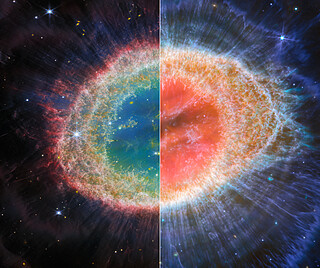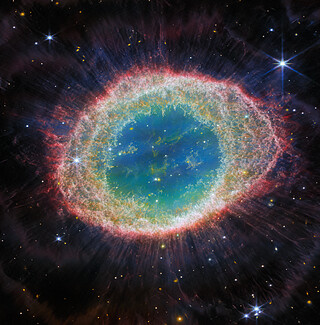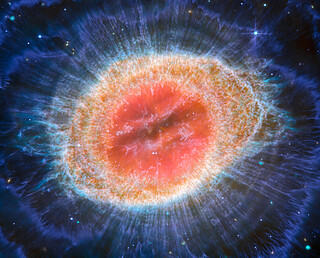weic2320 — Photo Release
Webb captures detailed beauty of Ring Nebula
21 August 2023
The NASA/ESA/CSA James Webb Space Telescope has observed the well-known Ring Nebula with unprecedented detail. Formed by a star throwing off its outer layers as it runs out of fuel, the Ring Nebula is an archetypal planetary nebula. The object is also known as M57 and NGC 6720, and is relatively close to Earth at roughly 2,500 light-years away.
The new images provide unprecedented spatial resolution and spectral sensitivity, which also reveal unique details across both infrared observations. For example, the new image from NIRCam (Near-InfraRed Camera) shows the intricate details of the filament structure of the inner ring, while the new image from MIRI (Mid-InfraRed Instrument) reveals particular details in the concentric features in the outer regions of the nebulae’s ring.
There are some 20,000 dense globules in the nebula, which are rich in molecular hydrogen. In contrast, the inner region shows very hot gas. The main shell contains a thin ring of enhanced emission from carbon-based molecules known as polycyclic aromatic hydrocarbons (PAHs). Roughly ten concentric arcs are located just beyond the outer edge of the main ring. The arcs are thought to originate from the interaction of the central star with a low-mass companion orbiting at a distance comparable to that between the Earth and the dwarf planet Pluto. In this way, nebulae like the Ring Nebula reveal a kind of astronomical archaeology, as astronomers study the nebula to learn about the star that created it.
The nebula is shaped like a distorted doughnut. We are gazing almost directly down one of the poles of this structure, with a brightly coloured barrel of material stretching away from us. Although the centre of this doughnut may look empty, it is actually full of lower density material that stretches both towards and away from us, creating a shape similar to a rugby ball slotted into the doughnut’s central gap.
The colourful main ring is composed of gas thrown off by a dying star at the centre of the nebula. This star is on its way to becoming a white dwarf — a very small, dense, and hot body that is the final evolutionary stage for a star like the Sun.
The Ring Nebula is one of the most notable objects in our skies. It was discovered in 1779 by astronomers Antoine Darquier de Pellepoix and Charles Messier, and was added to the Messier Catalogue. Both astronomers stumbled upon the nebula when trying to follow the path of a comet through the constellation of Lyra, passing very close to the Ring Nebula.
These observations were completed as part of the James Webb Space Telescope observing programme GO 1558. To learn more about the team’s research of these new observations, see the latest NASA Webb blog here.
More information
Webb is the largest, most powerful telescope ever launched into space. Under an international collaboration agreement, ESA provided the telescope’s launch service, using the Ariane 5 launch vehicle. Working with partners, ESA was responsible for the development and qualification of Ariane 5 adaptations for the Webb mission and for the procurement of the launch service by Arianespace. ESA also provided the workhorse spectrograph NIRSpec and 50% of the mid-infrared instrument MIRI, which was designed and built by a consortium of nationally funded European Institutes (The MIRI European Consortium) in partnership with JPL and the University of Arizona.
Webb is an international partnership between NASA, ESA and the Canadian Space Agency (CSA).
Image credit: ESA/Webb, NASA, CSA, M. Barlow, N. Cox, R. Wesson
Links
- ESA Webb Seeing Farther Interactive Brochure
- Hubble’s view of the Ring Nebula
- Release on ESA website
- STScI blog
- NASA Webb blog
Contacts
Bethany Downer
ESA/Webb Chief Science Communications Officer
Email: [email protected]
Ninja Menning
ESA Newsroom and Media Relations Office
Email: [email protected]
About the Release
| Release No.: | weic2320 | |
|---|---|---|







